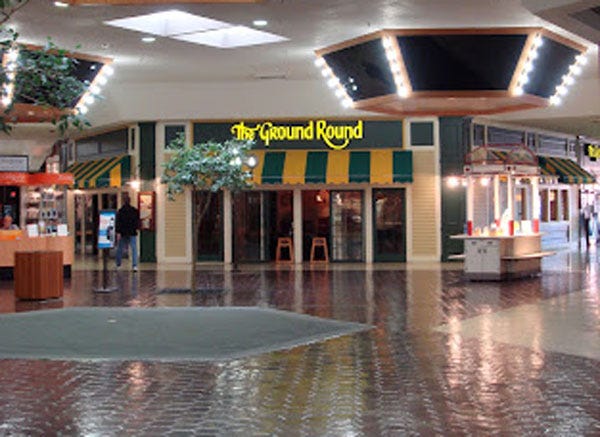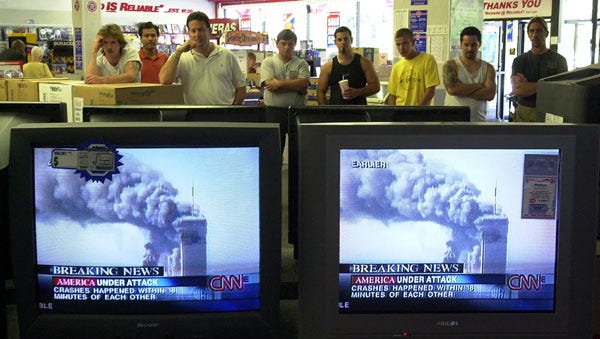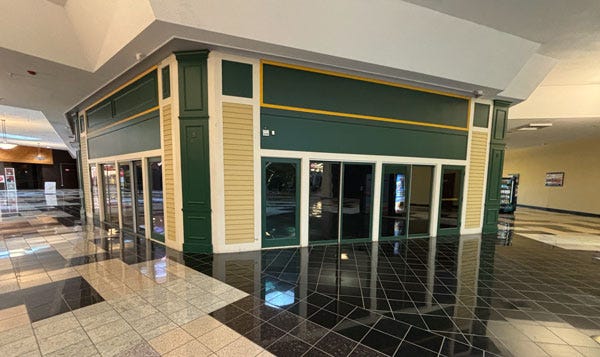Wednesday Walk: The Communal TV
How technology has changed our perception of Lebanon and hurricanes, plus the answer to last week's architectural quiz
Welcome to Willoughby Hills!
Every Wednesday, I offer a few short ideas that I hope will inspire you to do some more reading, thinking, and exploring. Let’s take a little walk together and see where the path leads…
Getting Distracted
On Monday night, I spent the evening at my kids’ school for a caregiver evening. Parents with children in the sixth grade met with my daughter’s teacher to discuss the curriculum, how the first weeks of school have been going, and what to look forward to in the year ahead.
My kids’ school follows a Waldorf philosophy, which I’ve written about before in this newsletter. One of the tenets of Waldorf education is protecting the delicate stage of childhood, allowing children time to explore the world around them, think critically about it, and form deep relationships with nature.
Rooted in this philosophy, many parents choose to limit technology in the household, whether that’s TV shows, cell phones, or video games. That looks different for each family, and our parent group fell into an organic discussion this week about how each family approaches technology.
One parent made the observation that during all of our childhoods, the home phone was a point of connection with friends from school. Very few families now maintain a home phone though, which means communication with peers needs to happen a different way, often through a cell phone or computer.
I’ve been thinking a lot about that parent’s observation since she said it and imaging what we gave up when we shifted from having a communal phone on the wall to having a personal phone in our pockets. Beyond that, many of our other communal devices, like TVs and computers, have also become handheld and personal.
This means that when news happens, we are no longer informed in a mass way. Around the anniversary of 9/11, I saw a post on my Instagram feed of the network newscasts from the hour or so before the first plane hit the World Trade Center. It was just a typical Tuesday in September as Al Roker joked with people waving signs in Rockefeller Plaza.
That led me down the rabbit hole of trying to remember what the news coverage looked like after the planes hit. I ended up watching quite a bit of the six hour NBC coverage of that morning that somebody had uploaded to YouTube and it took me right back to the uncertainty of that day where the only way to get information was through watching a national news network in real time.
On 9/11, I was in my first semester taking classes at our local community college and distinctly remember watching the coverage on the monitors outside of the campus TV studio, then having the college move all of us to a large theater where the broadcast was being played to accommodate the student body.
There are certainly criticisms that can be leveled against the national media relative to 9/11, and absolutely for the warmongering that followed in the press, but there is something to be said for the collective nature of that experience.
These days, information is no longer communal. It is personally tailored, meaning many of the most important stories never even make it to us.
You may not even know that Israel has spent the last few days bombing Lebanon, killing more than 500 people including 50 children. Or that the state of Missouri executed a man last night, despite prosecutors and the victim's family arguing against his death. And why would you know?
The trouble is real information is competing with everything else that’s on the internet and social media. So depending on what the algorithm thinks you’ll like, you may be served videos of bloodied severed bodies, but you may also see silly sketch comedy, short clips from old sitcoms, prank videos, cooking videos, or any other myriad distractions from what’s actually happening in the world.
Nightly newscasts and newspapers had their flaws, but they were fundamentally human endeavors. The information presented was curated by reporters, producers, and editors, but it was still a very human process. Relying on social media for news means letting a non-human entity (the algorithm) determine what we should know.
Go try to search for news on Lebanon on social media right now. I tried it on Threads (the Twitter competitor launched by Meta, owner of Facebook). One of the top hits for “Lebanon” is an AI generated image. How is that helpful?
Israel’s attack on Lebanon is not acting in a vacuum or divorced from the U.S. In fact, Netanyahu’s government is acting with the full support of the United States. Just last month, President Biden authorized another $20 billion in weapons to Israel, weapons that are now being deployed beyond Gaza.
This is information that every American should have. Our tax dollars are being used to fund the murder of civilians. Meanwhile, our bridges collapse, our health care system sucks, and there’s another hurricane about to strike Florida. Did you know about that one? Probably not, because the algorithm feeds us dances and cat videos instead of actual news.
The genie is out of the bottle at this point. We aren’t ever going back to a world made entirely of wall-mounted phones, nightly newscasts, or even a shared baseline of facts in this country.
What works for me, and what seems to work for the majority of the parents present at the meeting the other night, is a mediated approach to all of this. In fact, it’s almost Amish, something I’ve explored before as well.
We may need phones to communicate in the modern world, but it doesn’t mean that we need to allow our lives to be ruled by the algorithm or the technology. Now, more than ever, it’s important to stay informed on our own terms, to know how your tax dollars are being spent, and to stand up and speak out when you see wrong in the world.
My heart breaks for the people of Lebanon, as it has for the people of Palestine. No people deserve what is happening right now. It’s more important than ever that we keep our eyes open to what’s really going on.
Did You Guess Right?
The truth is, I’m just as guilty as any of us when it comes to distraction. These Wednesday Walks are meant to be a smattering of random topics. So much like a social media feed, let’s transition from a mass casualty attack to some random pop culture stuff.
Last week, I shared a photo from a vacant storefront inside the Hampshire Mall in Hadley, MA. To refresh your memory, here’s what it looks like:
To me, the dark green, gold, and yellow color scheme was a dead giveaway. I also gave the clue that this location had some ties to Howard Johnson’s, which was a big focus of last week’s Wednesday Walk.
So any idea what this once was?
This was once the site of The Ground Round restaurant, as this photo from 2007 proves.

I’ve written about the Ground Round before, having visited one that fell victim to the pandemic in Pennsylvania last year. Here’s some of the history of the chain that I wrote about at the time:
“The Ground Round was actually an offshoot of Howard Johnson’s restaurant business when it was founded in 1969. At the time, HoJo’s main focus was on serving travelers along busy roadside routes, and The Ground Round was an attempt to make a neighborhood restaurant that would cater to local tastes.
The restaurant targeted to kids, families, and young adults with an eclectic mix of offerings. There was a clown that made appearances, bottomless baskets of peanuts, and sometimes, quite the party scene (a death in the parking lot at a Ground Round in Massachusetts led to my state banning all happy hours).
At its peak, The Ground Round had 200 restaurants, some corporate owned, some franchised. The restaurant chain was sold a number of times over the years, before eventually declaring bankruptcy in 2004. 59 corporate owned locations closed, but 72 franchised locations continued to operate. The franchisees eventually banded together and formed a company to run their locations.”
There isn’t a ton of documentation available online for the former location in Hadley that would indicate when or why it closed. My guess is it was a victim of the Great Recession era, in part because the photo above is from a 2007 blog post when the location was still in operation, but there’s not much after that. The Yelp page only has a single review from 2006 (it earned four stars out of five).
The lack of a digital trail for this location is noteworthy for a few reasons. For one, The Ground Round seems to be the kind of place that you went for a simple night out with the family- meant more as a neighborhood hangout than a destination. We often like to mark special meals with photos or reviews, but are less likely to do so for more run of the mill, everyday places.
But also, it shows how differently we used the internet in the early 2000s. It’s common now to be able to see photos of most restaurant exteriors, interiors, and menu items on sites like Yelp and Trip Advisor, but that simply wasn’t as common two decades ago.
If you recognized The Ground Round from last week, pat yourself on the back. You know your obscure mall businesses from past eras!
I publish new issues every Wednesday and Sunday. Sign up to always receive the latest issue and support my work:
Other Wednesday Walks
If you’ve missed past issues of this newsletter, they are available to read here.







